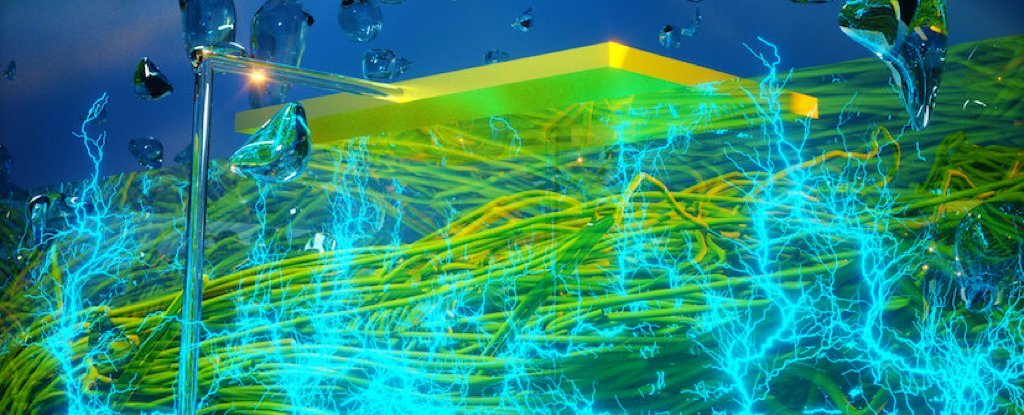好消息,科学家们制造了一种可以“在稀薄空气中”发电的装置
好消息,科学家们制造了一种可以“在稀薄空气中”发电的装置
They found it buried in the muddy shores of the Potomac River more than three decades ago: a strange "sediment organism" that could do things nobody had ever seen before in bacteria.
30多年前,在波托马克河泥泞的岸边发现一种奇怪的“沉积物生物”,它能做以前没人在细菌中见过的事情。
This unusual microbe, belonging to the Geobacter genus, was first noted for its ability to produce magnetite in the absence of oxygen, but with time scientists found it could make other things too, like bacterial nanowires that conduct electricity.
这种不寻常的微生物属于地球细菌属,最初因其在无氧条件下产生磁铁矿的能力而闻名,但随着时间的推移,科学家们发现它也可以制造其他东西,例如导电的细菌纳米线。
For years, researchers have been trying to figure out ways to usefully exploit that natural gift, and this year they might have hit pay-dirt with a device they're calling the Air-gen. According to the team, their device can create electricity out of… well, almost nothing.
多年来,研究人员一直在试图找到有效利用这种天赐的方法,今年他们可能已经用一种叫做“Air-gen”的设备赚了一笔。据研究小组称,他们的设备可以在几乎没有任何东西的情况下发电。

We are literally making electricity out of thin air, said electrical engineer Jun Yao from the University of Massachusetts Amherst back in February. "The Air-gen generates clean energy 24/7."
“我们实际上是在无中生有地发电,”麻省大学阿姆赫斯特分校(University of Massachusetts Amherst)的电气工程师姚俊今年2月说。“Air-gen可以全天候提供清洁能源。”
The claim may sound like an overstatement, but a recent study by Yao and his team describes how the air-powered generator can indeed create electricity with nothing but the presence of air around it. It's all thanks to the electrically conductive protein nanowires produced by Geobacter (G. sulfurreducens, in this instance).
这种说法听起来可能有点言过其实,但姚和他的团队最近的一项研究描述了这种Air-gen是如何在周围只有空气的情况下发电的。这全都归功于Geobacter生产的导电蛋白质纳米线(在本例中为G. sulphreducens)。
The Air-gen consists of a thin film of the protein nanowires measuring just 7 micrometres thick, positioned between two electrodes, but also exposed to the air.
Air-gen由仅7微米厚的蛋白质纳米线薄膜组成,位于两个电极之间,但也暴露在空气中。
Because of that exposure, the nanowire film is able to adsorb water vapour that exists in the atmosphere, enabling the device to generate a continuous electrical current conducted between the two electrodes.
由于该暴露,纳米线膜能够吸收大气中存在的水蒸气,从而使该装置能够产生在两个电极之间传导的连续电流。
The team said the charge is likely created by a moisture gradient that creates a diffusion of protons in the nanowire material.
研究小组说,电荷可能是由纳米线材料中产生的质子扩散的水分梯度造成的。
This charge diffusion is expected to induce a counterbalancing electrical field or potential analogous to the resting membrane potential in biological systems, the authors explained in their study.
作者在他们的研究中解释说:“这种电荷扩散预计会产生一种平衡电场或电位,类似于生物系统中的静息膜电位。”
A maintained moisture gradient, which is fundamentally different to anything seen in previous systems, explains the continuous voltage output from our nanowire device.
“维持水分梯度,这与以前的系统所见的根本不同,这说明了我们纳米线器件的连续电压输出。”
The discovery was made almost by accident, when Yao noticed devices he was experimenting with were conducting electricity seemingly all by themselves.
这个发现几乎是偶然的,当时姚注意到他正在试验的设备似乎都是自己导电的。
Previous research has demonstrated hydrovoltaic power generation using other kinds of nanomaterials – such as graphene – but those attempts have largely produced only short bursts of electricity, lasting perhaps only seconds.
之前的研究已经证明了利用其他种类的纳米材料——如石墨烯——来产生水伏打电,但这些尝试基本上只产生了短暂的电爆发,可能只持续几秒钟。
By contrast, the Air-gen produces a sustained voltage of around 0.5 volts, with a current density of about 17 microamperes per square centimetre.
相比之下,Air-gen产生的持续电压约为0.5伏特,电流密度约为每平方厘米17微安。
That's not much energy, but the team said that connecting multiple devices could generate enough power to charge small devices like smartphones and other personal electronics – all with no waste, and using nothing but ambient humidity (even in regions as dry as the Sahara Desert).
这个能量并不多,但研究小组表示,连接多个设备可以产生足够的能量为小型设备充电,比如智能手机和其他个人电子产品——所有这些都不浪费,而且只使用环境湿度(即使在像撒哈拉沙漠这样干燥的地区)。
The findings are reported in Nature.
研究结果发表在《自然》杂志上。


















